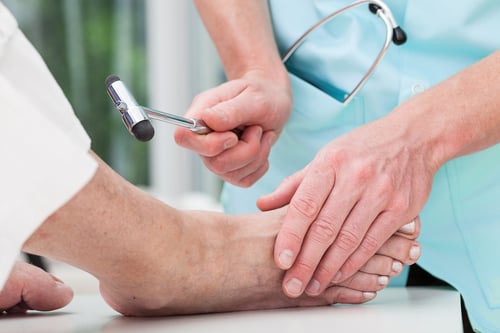
When you think of body parts affected by Cancer you probably instantly think of the lungs, probably the breasts, and the largest organ of all – skin. That’s understandable, as they are all in the top five most common types of cancer. When talking about skin cancer there are eight places where you should pay most attention.
You probably weren’t surprised to see the face, neck and back on that list. But did Number Eight - soles of your feet - surprise you? That’s most likely due to the skin on our feet, particularly the soles, are often overlooked when we apply sunscreen. In fact, professional ballroom dancer, Witney Carson, discovered melanoma on her foot in 2015 at the age of 22.
Here are 3 types of skin cancer that can affect your feet and what to look for
1. Squamous Cell Carcinoma is a non-melanoma skin cancer that usually originates from sun-damaged, inflamed or injured skin. It’s the number one type of foot skin cancer. This kind of skin cancer is typically non-aggressive and will live in the skin without spreading. However, if left untreated it can become more aggressive in later stages and then spread through the body.
What it can look like: Squamous Cell Carcinoma first appears in the form of a small, firm red bump but can also be a flat patch with a scaly or crusty surface. It frequently has irregular borders and can be itchy and/or bleed. It is often mistaken for a wart, eczema or some sort of foot fungus.
2. Basal Cell Carcinoma is also a non-melanoma skin cancer. It typically develops on parts of the skin that get frequent sun exposure and is most common in people over the age of 40, but younger adults can also be affected. It is the most common form of skin cancer in the United States.
What it can look like: Basal Cell Carcinoma appears as pearly white bumps or patches that may bleed easily, ooze or crust, like an open sore. This form of cancer is not as fast moving or aggressive as others, but can still be lethal if it goes unnoticed and untreated. If you see anything questionable you should reach out to your doctor immediately.
3. Malignant Melanoma is one of the most deadly skin cancers known. It is aggressive and often spreads through the lymphatic system and blood vessels to other parts of the body quickly. For the best chance of survival, malignant melanoma needs to be detected early. Surgical treatment is almost always prescribed. Feet are not immune to melanomas, they can develop on the skin or underneath the toenails.
What it can look like: Check for new spots, and pay attention to existing spots to quickly identify malignant melanoma. This cancer commonly appears as a small black, brown, pink or red spot – most of the time they resemble a mole, blood blister, wart, bruise or ingrown toenail. Remember – these spots can evolve under the nail, looking like a bruise or foreign object, like dirt.
If you’re unsure if your marking is a common mole or melanoma, you can use this list of ABCD symptoms to help guide you:
- Asymmetrical: Growths are uneven shapes – one side does not mirror the other side.
- Border: Generally, common moles have smooth, distinct edges. Any mark with bumpy, jagged or blurred borders should be looked at by your podiatrist.
- Changes in Color: Growths with more than one color, or changes color over a period of time, should be checked out by a professional. Colors can include black, brown, tan, pink, red or white.
- Diameter: Any spot that increases in size, is larger than 6 millimeters in diameter or develops suddenly should be checked out.
If you are notice any of the above symptoms, or are still unsure, contact us today to schedule an appointment. Visit our website to learn more about common foot disorders.






